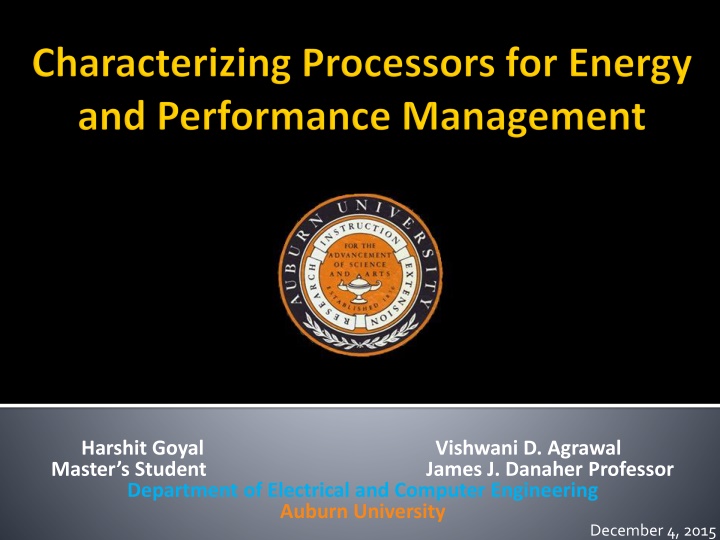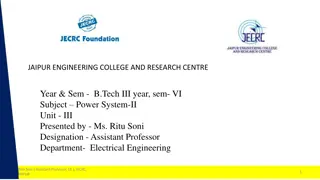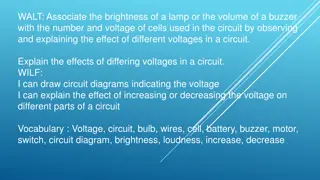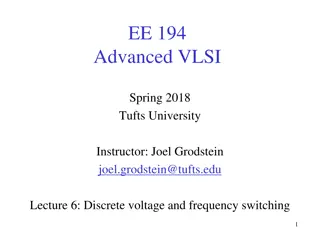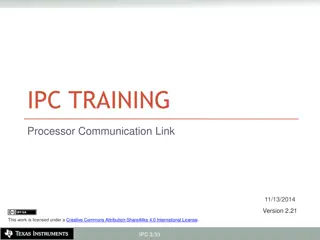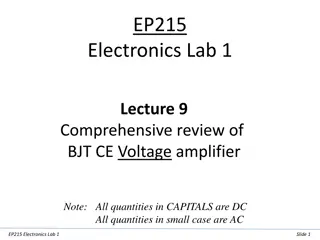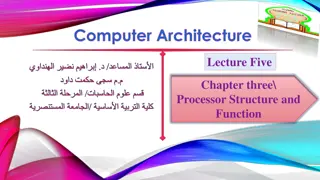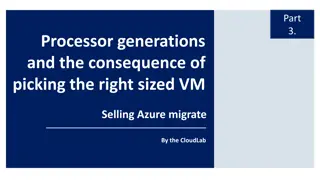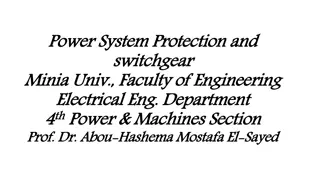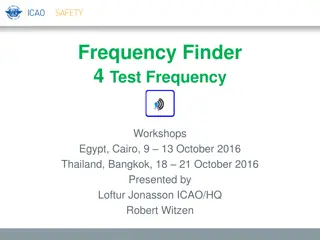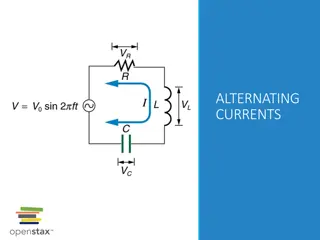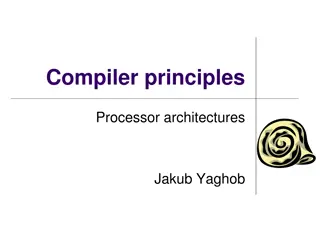Optimizing Processor Power and Performance Through Voltage and Frequency Management
In this study, data on voltage, frequency, and cycle efficiency of a processor are analyzed to determine optimal operating conditions for energy-efficient operations. The research explores dynamic and static power dissipation mechanisms and discusses the concept of characterization over process, voltage, frequency, power, and temperature. Details on time performance and energy performance of a processor are also covered, along with technology characterization involving simulating adder circuits to develop power management scenarios based on cycle efficiency and frequency.
Download Presentation

Please find below an Image/Link to download the presentation.
The content on the website is provided AS IS for your information and personal use only. It may not be sold, licensed, or shared on other websites without obtaining consent from the author.If you encounter any issues during the download, it is possible that the publisher has removed the file from their server.
You are allowed to download the files provided on this website for personal or commercial use, subject to the condition that they are used lawfully. All files are the property of their respective owners.
The content on the website is provided AS IS for your information and personal use only. It may not be sold, licensed, or shared on other websites without obtaining consent from the author.
E N D
Presentation Transcript
Harshit Goyal Vishwani D. Agrawal Master s Student James J. Danaher Professor Department of Electrical and Computer Engineering Auburn University December 4, 2015
Problem Statement Background Methodology Simulation setup Results Applications Conclusion February 28, 2025 MTV 2015 2
Obtain data on voltage, frequency and cycle efficiency of the processor for power and performance management. Determine operating conditions (voltage and frequency) for optimal time energy operations. February 28, 2025 MTV 2015 3
Dynamic Power Due to charging and discharging of capacitances. Short Circuit Power Occurs during signal transitions when both pullup and pulldown paths are partially conducting causing a direct path between Vdd and GND. Static Power This power dissipation occurs all the time through leakage even when the device is in standby mode. February 28, 2025 MTV 2015 5
What is Characterization? Characterization over Process, Voltage, Frequency, Power, Temperature Performance Metric Energy Efficiency Metric February 28, 2025 MTV 2015 6
Time Performance of Processor Speed of a processor is measured in cycles per second or clock frequency (f). Execution time of a program using C clock cycles = C/f Time performance = f/C Energy Performance of a Processor Efficiency of a processor may be measured in cycles per joule or cycle efficiency ( ). Energy dissipated by a program using C clock cycles = C/ Energy performance = /C February 28, 2025 MTV 2015 7
Technology Characterization Simulate a reasonable size adder circuit using selected vectors. Scale adder data to obtain processor power (cycle efficiency) and frequency at different operating points using scale factors. Develop power management scenarios using cycle efficiency and frequency. February 28, 2025 MTV 2015 8
Questa Sim Design, compile and simulate designs Leonardo Spectrum ASIC and standard cell synthesis Design Architect-IC Schematic Capture HSPICE Circuit simulation and verification February 28, 2025 MTV 2015 9
Adder circuit Fundamental block of functional units Often in processor s critical path Used 16-bit Ripple Carry Adder. PTM Models Characterized in two PTM models: bulk CMOS and High-K Technology node: 45nm, 32nm and 22nm February 28, 2025 MTV 2015 10
1000 random vectors were generated using a MATLAB code Simulation in H-spice at voltage 1.4v and frequency 1.3GHz gives cycle avg. power 100 vectors were selected such that: 34 consume avg. power 33 are above avg. power including the peak power vector 33 consume below avg. power including the min. power vector. February 28, 2025 MTV 2015 12
Maximum Frequency ???(GHz) 3.12 2.95 2.77 2.59 2.39 1.96 1.5 1 0.56 0.22 0.0529 0.0226 0.0089 0.0036 0.0014 0.0005 Average Power ( W) Static Power ( W) Peak Power ( W) Voltage (v) Critical path Delay (ps) Dynamic Power ( W) Average EPC (fJ) Peak EPC (fJ) 1.2 1.15 1.1 1.05 1 0.9 0.8 0.7 0.6 0.5 0.4 0.35 0.3 0.25 0.2 0.15 321 339 360 386 419 510 666 1002 1780 4522 18910 44163 112700 279360 715480 1852000 138 113 92 74 60 38 22 11 4.85 1.39 0.252 0.1069 0.0508 0.0253 0.0138 0.0074 106 91 77 64 53 35 20 10 4.43 1.18 0.1734 0.0555 0.0174 0.0044 0.0011 0.0002 33 22 15 10 7.25 3.57 1.78 0.92 0.42 0.21 0.0786 0.0513 0.0334 0.0209 0.0127 0.0072 413 358 304 249 198 130 74 38 15 4.45 0.7251 0.2433 0.0862 0.037 0.0174 0.0086 44 38 33 29 25 19 15 11 8.63 6.27 4.76 4.72 5.72 7.08 9.85 13.68 133 121 110 96 83 66 49 38 28 20 13.71 10.74 9.71 10.33 12.47 15.86 Simulation Data from H-spice for 32nm Bulk CMOS PTM Model February 28, 2025 MTV 2015 13
Processor Specifications: Intel Sandy bridge 2500K Technology node - 32nm Voltage range 1.2v to 1.5v Overclock Speed ( ?)- 5.01GHz Clock Speed ( ?)- 3.3GHz Peak Power (??)-125.6W TDP (??)- 95W Assuming that voltage was not raised for overclock frequency, using the equations below we found the static (36W) and dynamic power (59W) for the processor at the rated voltage 1.2 volts. ??= ?? ?? ?? ?? ?? ? ??= ?? ?? February 28, 2025 MTV 2015 14
All the scaling factors were found using processors specifications given at rated voltage 1.2v. Scale Factors Calculated Values Scale factors for processor s EPC: EPC SCALE FACTORTDP = ?????? ????????? EPC SCALE FACTORTDP EPC SCALE FACTORPEAK 0.583 ?????? ????? 0.347 EPC SCALE FACTORPEAK = ??????? ????????? ??????? ????? 0.786 1.107 ??? 0.526 ??? a Scale factors for processor s frequency: b Structural Constrained Frequency: =????????? ? ????????? ????? ? ????????? Power Constrained Frequency (a and b): ? =??????? ????????? ? ??????? ????? ???????? ????????? ? ?????? ????????????? ?????????? ? = February 28, 2025 15 MTV 2015
Because our own greatest access and insight involves Intel designs and data, our graphs and estimates draw heavily on them. February 28, 2025 MTV 2015 16
Power constrained frequency : It is the frequency that is limited by the maximum rated power (TDP) for the circuit under test. Power Constrained Frequency =??? ? ??????? ????? ? ?????????? ????? Structure constrained: It is the frequency that is limited by the structural (critical path) delay of the circuit under test. Structural Constrained Frequency = ????? ? ????????? February 28, 2025 MTV 2015 18
Structural Constrained Frequency ???(GHz) 5.685 5.366 5.01 4.74 4.67 4.46 4.16 3.84 3.15 Power Constrained Frequency (GHz) Voltage (v) 1.3 1.25 1.2 1.15 1.136 1.1 1.05 1 0.9 1.144 2.23 3.3 4.38 4.67 5.38 6.41 7.45 9.8 February 28, 2025 MTV 2015 19
TIME AND ENERGY FOR A PROGRAM THAT EXECUTES IN 2 BILLION CLOCK CYCLES Total TDP Energy Consumed by Program (Joules) Power Cycle Frequency f (GHz) Execution Time (Seconds) Consumption (Watts) Voltage ??? (V) Efficiency (MHz/Joules) ? ? ? ? Nominal Operating Voltage (1.2V) 3.3 34.74 95W 0.61s 57.57 J At 3.3 (80% task) At 5.01 (20% task) Operating Voltage (1.2V) Overclocked at 5.01GHz 0.48 36.8 34.74 76W 101W 0.56s 56.8 J 0.0798 20 26W 39.88 Optimum Operating Voltage (1.136 V) 0.43s (30%) 40.69 J (30%) 4.67 49.15 95W February 28, 2025 MTV 2015 20
The results shows efficiency improvement method for processor. Applicable to any technology node for which the modelling data is available. Power management can achieve higher performance (30% reduction in execution time and 30% lower energy consumption) Overclocking with increase in voltage can still improve the performance further. February 28, 2025 MTV 2015 21
[1] D. A. Patterson and J. L. Hennessy, Computer Organization& Design, the Hardware/Software Interface. San Francisco, California: Morgan Kaufman, fourth edition, 2008. [2] Aditi shinde and V. D. Agrawal, Managing Performance and Efficiency of a Processor , in proc. 45th Southeastern Symp. System Theory, 2013. [3] "CPUBoss." CPUBoss. Web. 25 Sept. 2014. [4] K. Kim and V. D. Agrawal, Dual Voltage Design for Minimum Energy using Gate Slack, in Proc. International Conf. on Industrial Technology, 2011, pp. 419 424. [5] K. Kim and V. D. Agrawal, Minimum Energy CMOS Design with Dual Subthreshold Supply and Multiple Logic-Level Gates, in Proc. International Symp. Quality Electronic Design, 2011, pp. 689 694. [6]. Bienia, C. et. al. The PARSEC benchmark suite: Characterization and architectural implications. The 17th International Symposium on Parallel Architectures and Compilation Techniques (2008). [7]. Borkar, Shekhar, and Andrew A. Chien. "The future of microprocessors."Communications of the ACM 54.5 (2011): 67-77. [8] Wang, A; Chandrakasan, AP.; Kosonocky, S.V., "Optimal supply and threshold scaling for subthreshold CMOS circuits," VLSI, 2002. Proceedings. IEEE Computer Society Annual Symposium on , vol., no., pp.5,9, 2002 February 28, 2025 MTV 2015 22
Thank You February 28, 2025 MTV 2015 23
